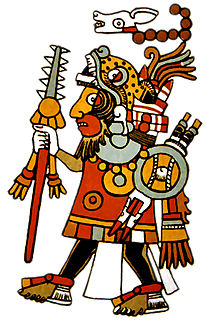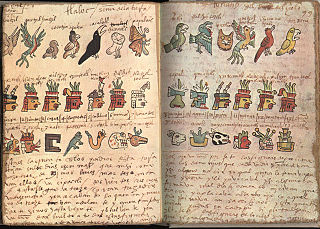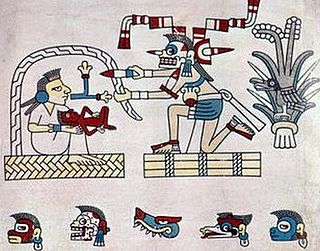
Eight Deer Jaguar Claw, or 8 Deer for briefness, was a powerful Mixtec ruler in 11th century Oaxaca referred to in the 15th century deerskin manuscript Codex Zouche-Nuttall, and other Mixtec manuscripts. His surname is alternatively translated Tiger-Claw and Ocelot-Claw. John Pohl has dated his life as having lasted from 1063 until his death by sacrifice in 1115. Consonant with standard Mesoamerican practice, the "Eight Deer" component of his name refers to his day of birth within the 260-day Mesoamerican cycle, which cycles through 13 numbers and 20 various signs.

Aztec codices are books written by pre-Columbian and colonial-era Nahuas in pictorial and/or alphabetic form. These codices provide some of the best primary sources for Aztec culture. The pre-Columbian codices mostly do not in fact use the codex form and are, or originally were, long folded sheets. These sheets were typically made from stretched deerskin or from the fibers of the agave plant. They also differ from European books in that they mostly consist of images and pictograms; they were not meant to symbolize spoken or written narratives.

The Codex Magliabechiano is a pictorial Aztec codex created during the mid-16th century, in the early Spanish colonial period. It is representative of a set of codices known collectively as the Magliabechiano Group. Others in the group include the Codex Tudela and the Codex Ixtlilxochitl.

Tilantongo was a Mixtec citystate in the Mixteca Alta region of the modern-day state of Oaxaca which is now visible as an archeological site and a modern town of Santiago Tilantongo. It is located at 17°15' N. Lat. and 97°17' W. Long. Its Mixtec name was Ñuu Tnoo-Huahi Andehui meaning Black Town-Temple of Heaven

The traditions of indigenous Mesoamerican literature extend back to the oldest-attested forms of early writing in the Mesoamerican region, which date from around the mid-1st millennium BCE. Many of the pre-Columbian cultures of Mesoamerica are known to have been literate societies, who produced a number of Mesoamerican writing systems of varying degrees of complexity and completeness. Mesoamerican writing systems arose independently from other writing systems in the world, and their development represents one of the very few such origins in the history of writing. The conquistadors brought their distinctive cultural baggage, in the form of books, from Spain to the New World.

The Codex Fejérváry-Mayer is an Aztec Codex of central Mexico. It is one of the rare pre-Hispanic manuscripts that have survived the Spanish conquest of Mexico. As a typical calendar codex tonalamatl dealing with the sacred Aztec calendar – the tonalpohualli – it is placed in the Borgia Group. It is a divinatory almanac in 17 sections.Its elaboration is typically pre-Columbian: it is made on deerskin parchment folded accordion-style into 23 pages. It measures 16.2 centimetres by 17.2 centimetres and is 3.85 metres long.

The Codex Tudela is a 16th-century pictorial Aztec codex. It is based on the same prototype as the Codex Magliabechiano, the Codex Ixtlilxochitl, and other documents of the Magliabechiano Group.

The Borgia Group is the designation given by scholars to a number of mostly pre-Columbian documents from central Mexico, first identified by Eduard Seler. The manuscripts have survived despite their having reached Europe at an early date. They are distinguished by their religious content, while the pre-Columbian codices of the Mixtec group are principally historical. The place of origin and the linguistic identity of the creators of the codices have been subject to debate, but may well be Puebla - Tlaxcala - Western Oaxaca. The main members of the Borgia Group are:

Mixtec writing originated as a logographic writing system during the Post-Classic period in Mesoamerican history. Records of genealogy, historic events, and myths are found in the pre-Columbian Mixtec codices. The arrival of Europeans in 1520 AD caused changes in form, style, and the function of the Mixtec writings. Today these codices and other Mixtec writings are used as a source of ethnographic, linguistic, and historical information for scholars, and help to preserve the identity of the Mixtec people as migration and globalization introduce new cultural influences.

The Codex Laud, or Laudianus, is an important sixteenth-century manuscript associated with William Laud, an English archbishop who was the former owner of this ancient Mexican codex. It is from the Borgia Group, and is a pictorial manuscript consisting of 24 leaves from Central Mexico, dating from before the Spanish takeover. It is evidently incomplete.

The Codex Colombino is a part of a Mixtec codex held in the collection of the National Museum of Anthropology in Mexico City. It is the only Mesoamerican codex that remains in Mexican territory. It deals with the genealogy, marriages and bellicose conquests of the Mixtec lord Eight Deer Jaguar Claw.
Yahui is a supernatural figure that takes on various mixtures of animal and human forms within the culture and belief systems of the Mixtec—indigenous Mixtecan-speaking people of La Mixteca in central-southeastern Mexico. It is an important and recurring motif in Mixtec iconography, thought and culture, especially during the pre-Columbian era. As a supernatural figure, the yahui appears in Postclassic Mixtec codices as an entity wearing a serpent or reptilian tail and headdress and the carapace of a turtle.

The Codex Bodley is an important pictographic manuscript and example of Mixtec historiography. It was named after the colloquial name of the Bodleian Library, where it has been stored since the 17th century.

Codex Vaticanus B, also known as Codex Vaticanus 3773, is an Aztec ritual and divinatory document. It is a member of the Borgia Group of manuscripts. It contains 49 leaves, 48 of them are painted on both sides.

Codex Vindobonensis Mexicanus I, also known as Codex Vindobonensis C, or Codex Mexicanus I is an accordion-folded pre-Columbian piece of Mixtec writing. It is a ritual-calendrical and genealogical document dated to the 14th century.
The Selden Roll is a 16th century Mexican manuscript painted roll from the Coixtlahuaca region, incorporating both Mixtec and Aztec elements, probably recording myths of the origin and migration of divine ancestors.















